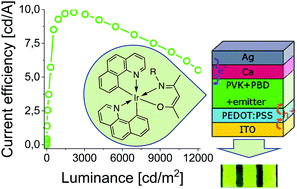Effect of fluorine substitution of the β-ketoiminate ancillary ligand on photophysical properties and electroluminescence ability of new iridium(iii) complexes†
Abstract
In this paper we report studies of the electronic structure as well as photophysical and emissive properties of a family of new heteroleptic iridium(III) complexes of the general formula [Ir(bzq)2(N∧O)] with N,O-donating β-ketoiminate ligands equipped with different directly fluorinated N-aryl moieties. For this purpose, a series of suitable β-ketoimines were prepared and successfully employed in the synthesis of iridium(III) phosphorescent materials. It is worth emphasizing that the developed synthetic strategy, involving the use of microwaves to accelerate the reaction course, allows reduction of the process time by up to 10 minutes. All the obtained complexes were characterized by spectroscopic methods and the structures of three of them were resolved by X-ray methods. The cyclic voltammetry measurements allowed determination of the energies of HOMO and LUMO levels of the studied complexes. Moreover, the HOMO–LUMO gaps predicted for these compounds by DFT methods showed a good correlation with the experimental values. The determined negligible influence of ligand modification on LUMO levels and only small change of HOMO levels explains the observed slight effect of different directly fluorinated N-aryl moieties on photophysical properties of the complexes. All Ir complexes were tested in host–guest type organic light emitting diodes (PhOLEDs) with an poly(N-vinylcarbazole):2-tert-butylphenyl-5-biphenyl-1,3,4-oxadiazole matrix. The PhOLEDs based on all studied iridium complexes emitted green light. The most efficient phosphorescent emitter turned out to be the iridium complex with one fluorine atom substituted in the para position in the phenyl ring of the ancillary ligand. Diodes with the emissive layer containing 1 wt% of this emitter showed the best operating parameters: luminance of about 13 000 cd m−2 and current efficiency close to 10 cd A−1. A comparison of photoluminescence, electroluminescence and spectrally resolved thermoluminescence spectra of the investigated systems revealed an important role of charge carrier trapping in the TL phenomena.



 Please wait while we load your content...
Please wait while we load your content...